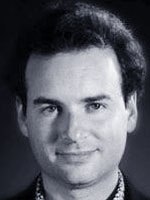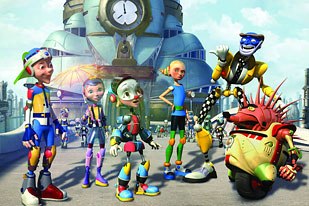Animator-turned director Daniel Robichaud tells Tulay Tetiker about the challenges of making the 3D-animated Pinocchio 3000 as a co-production of Canada, France and Spain.

P3K: Pinocchio 3000 is a futuristic spin on Carlo Collodis classic tale, filmed in visually stunning 3D animation, in which Geppettos ultimate creation is a robot, rather than a wooden marionette.
Geppetto, with the help of his loyal assistant Spencer, the cyber penguin, (voiced by Howie Mandel) creates Pinocchio, a one-of-a- kind super-robot equipped for imagination, thanks to the P3K microprocessor. But Scamboli, Geppettos archrival, thinks that kids disrupt the perfect order of his techno city Scamboville, and builds an amusement park to contain them all in one spot. Scamboli then manipulates Pinocchio into helping him with a devious scheme to turn all of the children into robots, but Pinocchio realizes that something is wrong. With the help of his friends, Pinocchio confronts Scamboli and learns the valuable lessons that Cyberina, the holographic fairy (voiced by Whoopi Goldberg) requires of him to make his dream come true. Adventure, action, a fathers love and a sons quest to discover what it means to a real boy! A cyber classic!

The idea of bringing this classic childrens tale into the 31st century began in 1998, when Medialab, a French 3D animation company, approached CinéGroupe to co-develop a variety of projects, P3K: Pinocchio 3000 among them.
Medialab executives were looking for a director and approached Daniel Robichaud with the task, after having seen his award-winning short Tightrope at Monte Carlos Imagina Festival. When they asked me to direct the still-in-development-film in 1999, I was instantly charmed by the originality of the script, as well as the early character designs explains Robichaud. The first challenge was to adapt both the designs and the screenplay to the requirements of the CG medium. To help the producers finding a way to finance the movie they created a two-minute animated trailer. The ultimate challenge, though, came when the project got the green light: we had 12 months and a modest budget (based on industry standards) to deliver the film, while assembling an animation team and defining a technical pipeline for the studio.
Robichaud started doing computer graphics in 1983 and worked for the Canadian national television (CBC) as a designer and art director. In the early `90s, he moved to Hollywood, enthusiastic about the fascinating new promises of the digital medium in high-end effects films. I was hired by Digital Domain as an animation director, and went on to contribute to such movies as Apollo 13, Terminator 2: 3D, The Fifth Element and Titanic. I also had the opportunity to direct my own animated short film, Tightrope, which caught the eyes of the producers of Pinocchio 3000. Before the movie went in production, I supervised character animation on three more film projects, The Scorpion King, K-Pax and Willard.

The films retro-futuristic style maximizes the potential of 3D animation. P3K provided me with the opportunity to develop a unique world, and not re-create one that exists already, as I had done in Titanic. When you do excellent special effects, the idea is that they are invisible! I welcomed the opportunity to be able to showcase my work. It was very important to me to be able to create excellence, even with the comparatively modest budget. I knew that if we planned well, we could achieve something special. And I think we did.
Even though it took years to get made due to the challenges of international financing and co-production, (AnimaKids of France and Castelao Films of Spain were brought on board). Creating a 3D film is an exercise in managing intricate details that are all dependent on each other, explains Philippe Garel of AnimaKids. If something goes wrong at the beginning of the process, it can cause major problems and costs. And add the co- production factor: trying to organize the work across two continents and in three languages and cultures. In fact, when the roles are clearly defined, the work flows much more smoothly.
Adds Castelao Films Paco Rodriguez, It is really a question of initially establishing a workflow that maximizes each partners talent, and [respecting] the needs of the project. And, of course, a good sense of humor helps.

Before beginning the production, the partners retreated to Spain for a weeklong brainstorming session, to finalize all of the millions of details and to organize the workflow and finalize the script. Robichaud explains: Even though time and resources were limited, the script called for complex effects and ambitious scenes with crowds and elaborate sets. On top of that, since Pinocchio 3000 was a co-production between Canada, France and Spain, the work had to be broken down and distributed among three different studios, on two continents. It was vital to define a straightforward and efficient process in creating our animations. We certainly learned how to do more with less.
The 10-month production schedule was incredibly demanding, but Montreal is renowned for its creative talent. So, Christian Garcia, computer graphics supervisor, had to first assemble a team together, under Robichauds supervision. AnimaKids was responsible for the script, visual development of the secondary characters, and for the set design; Castelao for the modeling and texturing of the sets, and all of the post-production for the sound and laboratory and finally CinéGroupe was taking care of the modeling and texturing of the primary characters, voice recordings, and the animation of the film animating, lighting, compositing, rendering and image post-production and overall quality control.

A team of 100 to 150 talented artists worked on Pinocchio 3000, according to Robichaud: The achievement that I am the most proud of, without hesitation, is the team of exceptionally talented artists we were able to assemble as soon as we got a green light. We could not have pulled it off without their expertise and dedication and to create bonds and work with a most creative crew. Also, to spend significant time in my hometown, Montreal, which I had left 10 years before I came back for this project.
All of the characters, props and sets were designed initially as 2D drawings, and then were, step by step, transformed into 3D using Softimage XSI. After applying the colors to the 3D model, the artists created the different textures that reproduced skin, cloth, steel, wood or whatever was previously decided, and included such properties as reflection, transparency and refraction to make it come alive.
Moreover, the rigging team built tools that the animators used to control the movements. These proprietary tools include preset elements (Synoptic Views) that pre-define how the hands will move, or facial expressions, so that the animators can make Pinocchio wave, without having to be concerned about any disharmony between the movements of his fingers.
The actual animation was done via keyframe. Thus, for an 80-minute film, there are 115,200 frames to be animated. To see the result of all the work, each layer was sent to the 8,500GB render farm to create the images.

For Robichaud, the visually challenging part of the movie was to maintain a warm, feel-good quality that would appeal to a young audience, in spite of the futuristic setting of the story. This was a film about a classic tale, and not a science-fiction movie, he explains. This principle gave birth to a unique vision of an improbable future world, and influenced not only the designs, but also the lighting, the effects and the colorful palette. Among the most visually rich sequences are the birth of Pinocchio, the Imagination Game and the flying car chase in the city.
With Pinocchio 3000 bound for North American theaters in early 2005, Robichaud is hard at work on his next animated feature, Frog Legs, a buddy story about two frogs who venture out of their pond and into the human world.
Tulay Tetiker is an industry expert, specialized in CG/Vfx. She has served as an editor for Digital Production magazine and CGChannel, and has a creative background as a freelance video editor. Currently, shes working as a PR manager and journalist and lives in Munich and Toronto.







